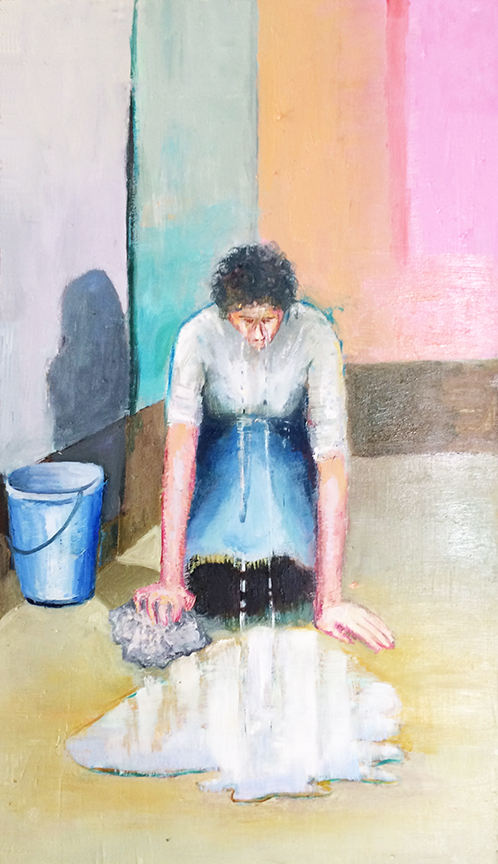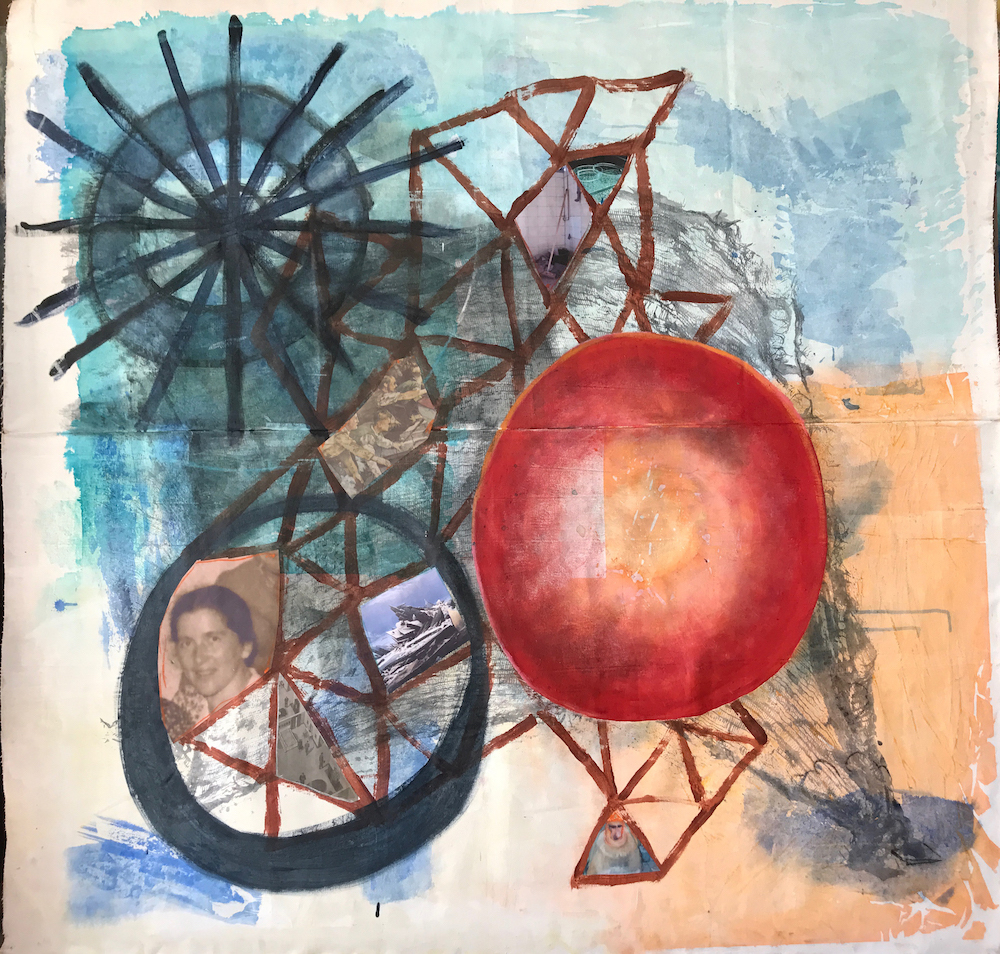At the beginning of the pandemic, April 2020, LA artists Katy Crowe and Margarete Hahner bumped into each other, waiting in line to get into Trader Joe’s. There, they decided to start working on a project together which would involve painting on each other’s paintings. While some people got busy fumigating all their groceries, baking bread, learning how to play piano or binging Netflix, these two were exchanging paintings. Clandestinely, of course, outside, masked and over coffee.
Katy has been working abstractly for almost 50 years, with geometric shapes, grids, transparencies, muted colors, using predominantly oil on linen. Contrast that with Margarete’s work which involves floating body parts, Hieronymus Bosch–like figures poised in space. How would this endeavor to work together turn out? The results are “Moulting,” the current show up at LA Tate Gallery.
I wondered about Katy and Margarete’s process together and suggested it might be interesting for them to interview each other. They looked at me inquisitively and then asked if I would do it. This is what emerged.
Julie Adler (JA): How did you two initially meet?
Margarete Hahner (MH): Through our mutual friend Larry Rickles. He curated a group show with us at Post for HK Zamani’s Kamikazes in 2019.
Katy Crowe (KC): And then, during a studio visit together, Margarete asked if I would make a painting with her.
What prompted you, Margarete, to ask Katy to do this?
MH: Well, for years, I have always wanted someone to finish my paintings. I always got to a certain point and then thought, “Now someone needs to do the final touches!” because I’m never sure when it’s done. There’s something I really like about Katy’s painting, the simplicity I crave. And that probably makes it easier. Because with me, it’s always too much, too many ideas.
KC: It’s the opposite for me, it’s completely not in my work at all, this kind of psychological narrative Margarete presents. It’s fantastical and strange.

Margarete Hahner Fountaine, 2018 oil/ wood, 13” x 23”
So are these works mostly Katy finishing Margarete’s paintings?
KC: No, we switch back and forth. Usually we work on two pieces at once. I would start one and Margarete would start one and then we would go for coffee. And then a month or so later, we would switch again.
When you get one of Margarete’s pieces and you start to put your mark on it, how do you feel?
KC: I think, ‘What does it need? Where can I take it?’ It’s going down a different road than I usually do. It’s broadening.
And Margarete, what happens for you?
MH: I watch what comes up in my mind and I follow it.
KC: For me, it’s also about making a painting work. When Margarete and I would decide that a painting was finished, it just felt right. Everything’s integrated in a way that makes it seem like there’s nothing else to do.

Katy Crowe Organza #25 2022, oil/organza/linen, 24” x 18 ”
I’ve noticed your palettes are quite similar, muted colors and there’s a blurriness to the lines. It actually seems like just one person did these works. It doesn’t feel like “Oh, that’s Katy making her mark on Margarete’s piece,” or vice versa.
MH: It’s why we sign the paintings under a different name, KAMA. Something else happened.
What’s KAMA?
MH: It’s the two first letters of our names.
Let’s talk about the title for your show: “Moulting” which means shedding old feathers, making way for new growth.
MH: Both of our last names have an association to birds. Katy’s last name is crow, and mine is Hahner, which means rooster in German. We are both losing our feathers.
And/or ruffling each other’s feathers a little bit?
MH: Yeah, that too. And, in doing so, you also grow. You get new feathers. I learned intimately someone else’s process. Katy let me look in her toolbox. It’s like you eat somebody. It’s a little bit like cannibalism.
Wow. Okay. Did you know that Margarete was feasting on your work there?
KC: I had no idea! But just exposure to someone else’s process or mind is really great. There’s still stuff to do, you know? I like to surprise myself. It made me freer too, not afraid to wreck something.
MH: Well, there was this one time, I was painting a candle. And it took me a long time. I tried to make it very realistic. And then Katy just painted over and I was like, ‘Oh no!’
KC: Losing, that’s part of the process. When I’ve done something and Margarete changes it, I have to let go. I love that aspect of it, not clinging. It’s out of my hands.

KAMA Ashtray/Matchsticks 2022, oil/acrylic/ink/canvas, 40 ½” x 41 ½”
Do you have a favorite painting in this show?
KC: Mine is Satellite. I loved Margarete’s final touches, the photographic images from magazines tucked in there.
MH: I like Ashtray/Matchsticks because it is so simple, direct, clear. With my own work, there’s usually a lot of ambiguity but not here.

KAMA, Satellite 2022, oil/acrylic/photos/canvas, 52” x 53 ¼”
Lastly, I want to turn it over to you two—if you were to interview each other, what would you ask?
KC: Where do we go from here? We are still making paintings but…where are we gonna go?
MH: We have some paintings in the pipeline and I started one that looks like you had done it and you also said you would do one that looks like mine and I’m still waiting to see it.
KC: KAMA has been busy.
MH: I want to know how you mix your wax. You use a specific technique that ends up in a pile and looks like an artwork in and of itself. What is it?
KC: It’s a mixture of beeswax and cold press oil.
MH: You see, it’s all espionage here.
Cannibalism and espionage.
MH + KC: You are what you eat.
Julie Adler is frequently uncomfortable. So is her art, which comes out of this awkward ‘in-between’ place. Born and currently based in Los Angeles, she is an interdisciplinary artist who employs a wide spectrum of mediums from painting to performance to singing to writing to explore things like having a body and the inevitable dissolution of it. She is also a heavy user of Buddhism and yoga. She has presented her work in places like REDCAT, Armory Center for the Arts, Highways, POST, The Situation Room, Susanne Vielmetter Los Angeles Projects, VICE Magazine and 7×7. She has an MFA in Visual Arts and Music from Cal Arts and BFA from Cooper Union.

